
Unusual June Chill in Reykjavík: Near-Freezing Temperatures and Snowfall Challenge Summer Norms
June in Reykjavík is typically a time of mild temperatures and long daylight hours, heralding the start of Iceland’s brief but vibrant summer. Average highs usually range between 10°C and 15°C, while lows rarely dip below 5°C. However, June 2025 brought an extraordinary weather anomaly to the Icelandic capital—daily temperatures hovering around a mere +0.5°C (32.9°F) alongside unexpected snowfall, nearly breaking the historic June record low of -0.7°C (30.7°F).
A Shock to the Summer Season
This near-freezing temperature in Reykjavík is highly unusual for June, a month when frost and snow are considered almost impossible in the lowlands. The persistent cold snap caused by a stubborn high-pressure system combined with an influx of cold Arctic air led to temperatures plummeting well below seasonal expectations.
Several nights in early June saw temperatures flirting dangerously close to freezing, with some recordings just a fraction above 0°C. This chilling pattern brought about light but persistent snowfall across the city, covering streets and rooftops with a thin, unexpected layer of snow. Residents, tourists, and local meteorologists were surprised by the wintry scene in the heart of Iceland’s summer.
Blizzard and Unseasonal Cold in Central Iceland’s Setur: A June Weather Anomaly
Iceland is renowned for its stunning landscapes, unpredictable weather, and unique climate phenomena. Typically, June marks the beginning of the Icelandic summer, celebrated for its mild temperatures and extended daylight hours, including the famed midnight sun. Visitors flock to the country during this time to experience pleasant weather and near 24-hour daylight. However, in early June 2025, Central Iceland’s Setur experienced an unusual weather event: a blizzard accompanied by temperatures plunging to around -3°C (26.6°F), dramatically diverging from the mild summer norms.
Typical June Weather in Setur
Under normal conditions, June in Setur is characterized by relatively mild and comfortable weather. Average high temperatures typically range between 10°C and 15°C (50°F to 59°F), while nighttime lows hover between 8°C and 9°C (46°F to 48°F). This pleasant temperature range, combined with the nearly continuous daylight, creates ideal conditions for exploring Iceland’s natural beauty, including its waterfalls, glaciers, and volcanic landscapes.
Iceland’s May 2025 Heatwave: A Record-Breaking Anomaly (+26,6°C, Egilsstaðaflugvöllur)
In May 2025, Iceland experienced an unprecedented heatwave that defied its typically cool climate. From May 13 to 22, a persistent high-pressure system near the Faroe Islands directed warm air from the south and southeast toward the country, leading to the most significant May heatwave ever recorded in Iceland. In Egilsstaðaflugvöllur, the maximum temperature reached +26,6°c which is the new national record for the month of May.
The weather can still be somewhat unpredictable due to Iceland’s location at the meeting point of the Arctic and North Atlantic weather systems, but sustained cold or snow in June is exceedingly rare.
Impact on Life and Activities
The unusual weather posed significant challenges for those living in and around SummerSetur. Farming activities, usually ramping up during June, were delayed due to the cold and snow-covered fields. Crops and livestock, not typically exposed to such harsh conditions at this time of year, required additional care to mitigate damage.
Tourism, a vital part of Iceland’s economy, also felt the effects. Many visitors planning hiking, sightseeing, and outdoor adventures found their plans disrupted or postponed. While the midnight sun still cast long hours of light, the bitter cold and blizzard conditions made outdoor activities difficult and sometimes unsafe.

Illustration picture: https://icelandmonitor.mbl.is/news/news/2025/06/03/june_begins_with_wintry_weather/

Climate records in Reykyavik. Source: https://en.wikipedia.org/wiki/Reykjav%C3%ADk


























